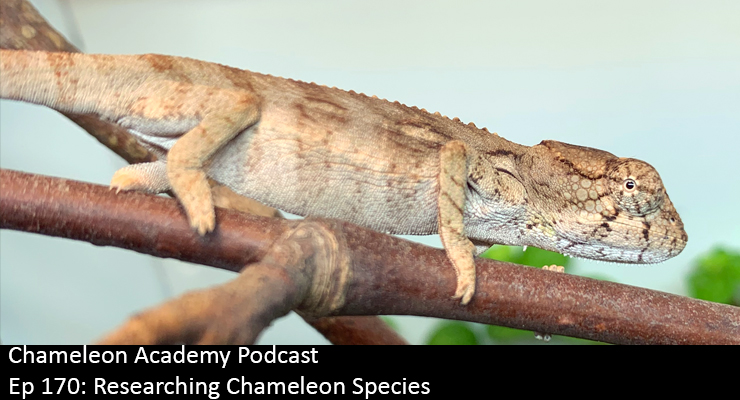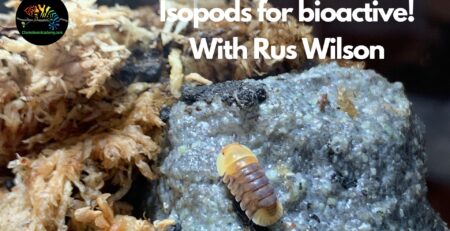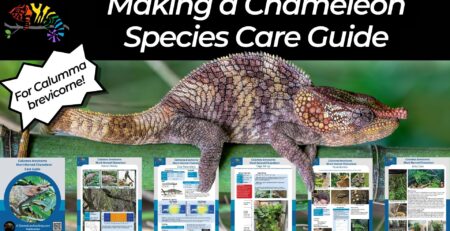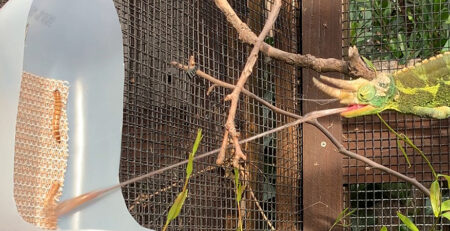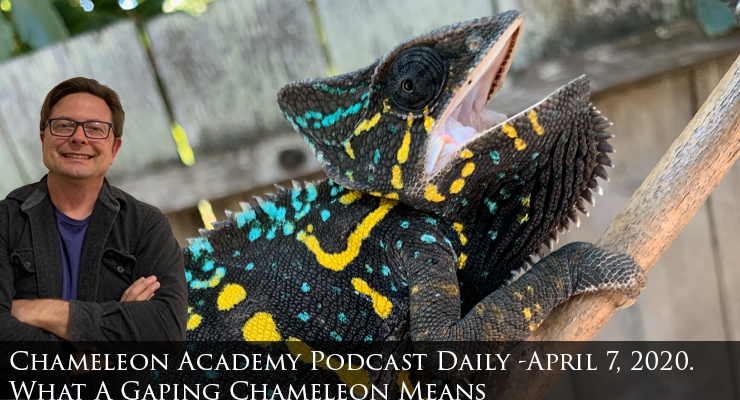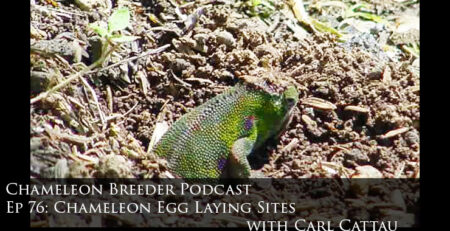Ep 170: Researching Chameleon Species
Listen Here!
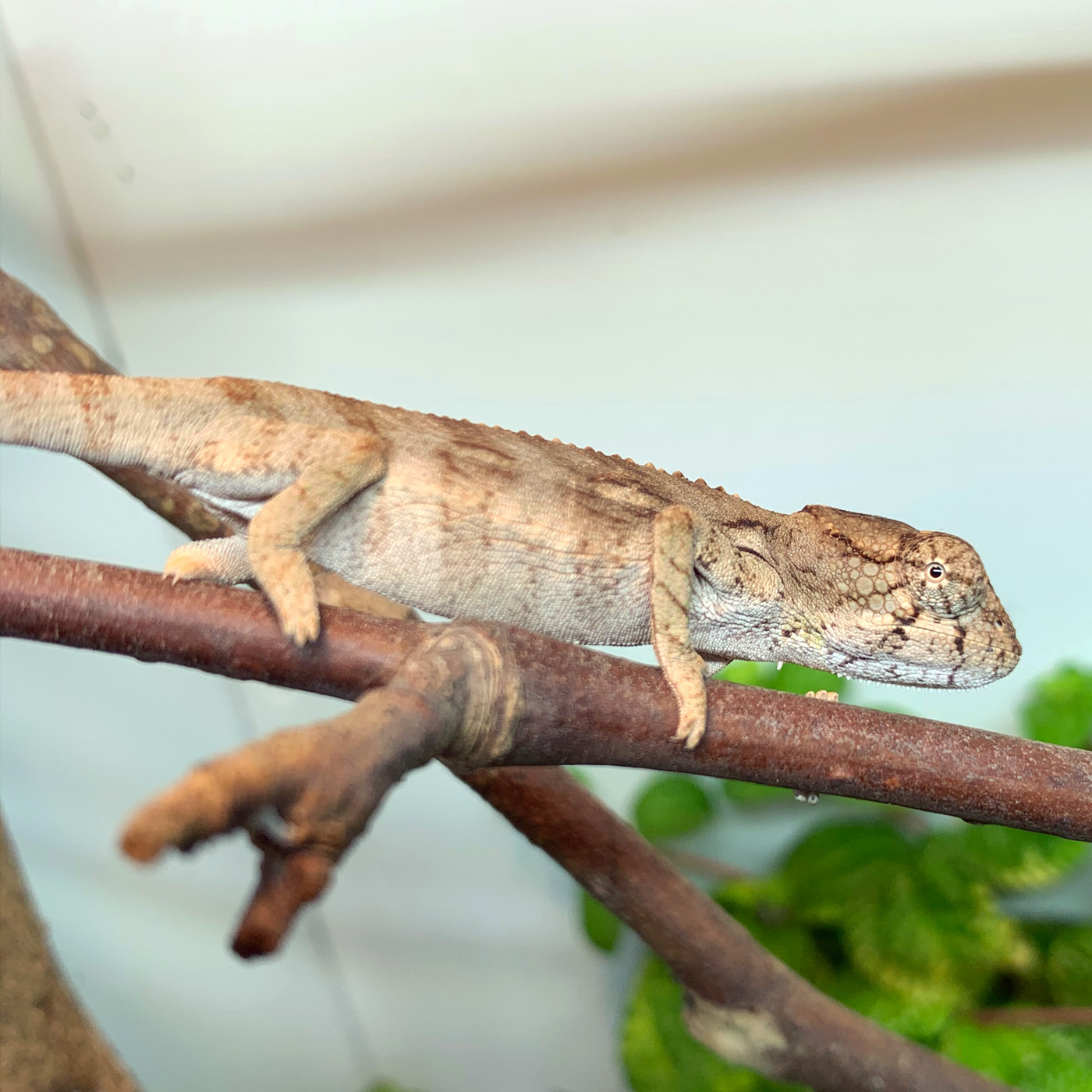

Bill Strand
Researching Chameleon Species
When you step into the chameleon world you find yourself in an immense undiscovered country. You never realized how many species of chameleons there are! So how do you go about learning the species just listed for sale? Today, I take you along with me as I gather information on a rarely available Captive Hatched chameleon species.
Transcript (more or less)
Sometime last year I got the news that, a friend of mine, Shane Boyd had eggs laid by his pair of Furcifer verrucosus. This was exciting because F. verrucosus is almost extinct in the US captive community. There are a few left here and there, but the likelihood that they are reproducing is very low. Though I would love to be proven wrong so please let me know if there are some hiding out there. Furcifer verrucosus is a large dragon-like chameleon. It is one of the Madagascar chameleons that come from the harsh, arid south and west. Although they tend to be available as wild caught when Madagascar is exporting, they are just like every other chameleon. As captive hatched they are like a completely different beast and I let Shane know way back then to please let me know when those eggs hatch because I wanted to be first in line. Furcifer verrucosus is one of the largest of the chameleons and so raising one from a baby would be a special experience.
I have the benefit of many years of experience behind me and, in a yesteryear, imported Madagascar species, including F. verrucosus so I knew how special this was and I already know what I am in for a year from now. But even I run into species that I may have heard of, but would not know how to care for beyond a basic general idea. So I thought this would be a great opportunity for me to pretend that I am new to F. verrucosus, do some research, and take you along. This is how I do my research on species and these resources are available to you as well. We’ll do it on Verrucosus today, but the techniques can be applied to any species.
So, let’s start at the beginning. I run across a classified on Chameleon Forums by Shane Boyd from RGB Reptiles saying he has captive hatched Furcifer verrucosus. Hmmm, I have not heard of that one before. The pictures posted of the parents pique my interest. They are kind of rugged looking with a cool back crest. And there are some people asking if it is a cross between a Veiled and a panther. So, there are more people out there that haven’t heard of this species. Well, the fact that it is off the beaten path makes it a little more interesting in my book. And so, I decide to pull out the light of truth called Google from whence all knowledge resides. Let’s type in Furcifer verrucosus. And the first thing I am going to do is going to look at the images. And…wow, this guy is kind of cool. Subtle greens but maybe some blues coming out in the chin area. Love the spiney back and the massive head. Looks like it is called the Warty or Spiny Chameleon. I can see spiny chameleon, but I can only guess the warty name came from the big scales on its cheeks. But no matter. I like the look of this guy. So I decide I am going to go to the next step. Clicking over in google to the text listing I see what is coming up. Now, you can always go straight to care sheets. But with these rare chameleons you need to be careful with what information you accept. I like to learn a little bit about their natural history before I look for care sheets and especially before I ask on social media. Knowing their natural history gives me a baseline familiarity that helps me pick out the people who know what they are talking about and get an idea of who might be trying to be helpful, but with a subject a bit out of their league. Of course, the most direct way, if you are getting a baby, to get information is to talk with the breeder. But if the chameleon is wild caught you don’t have that option. And, take it from a guy who did this all the time, the more you know going into the call with the breeder the more you will know what questions to ask that you may not have thought to ask before. So, even if you have a benefit of a breeder to talk with, this preliminary research stage is invaluable. So, let’s do a little research and see what we come up with.
Here are the digital places I go to get what I know to be good information:
First, check Chameleon Academy to see if there are any podcast episodes on this species. I interview people who have bred their chameleons and have a background to be giving advice. The big advantage is that I have vetted them for you so you know you are getting good information. But, searching through the Chameleon Academy Podcast archives, I do not have an episode on Furcifer verrucosus. Beyond the podcasts you have the following sites which have solid information.
Adcham.com – Adcham stands for Advanced Chameleon and was a group started on the listserves of the late 90s. This group was intended to bring together the experienced community to have higher level discussions. Many members of this group got together to create a website of the same name which would be a repository of as much information as we could stuff in there. What we ended up with was a massive amount of information. Although it is a couple decades old, most of the information is still good today. The reason why I bring up a website that has some years on it is that it has a pretty healthy collection of profiles of rare species so it is still a valuable resource. So it is a good place to search and I did find a very good species profile that was detailed and got me on the right track. Here I learn that there are two subspecies and that the gravid female has some spectacular colors. More importantly I learn about ambient temperatures in the 80s with a 15 degree drop during the humid night. Now, I always will cross check the temperatures and compare sources unless I am familiar enough with the sources to know I can trust it. So, a good haul of information. But, really, if you think about it, my purpose in doing this research is natural history. Since these are captive hatched one of my stops in my research period will be to communicate with the breeder and that will probably be my most reliable source of up to date husbandry information. So at this point I am digging around to make sure I ask the breeder intelligent questions.
Chameleonnews.com is another information ladened site. This was actually a regularly published digital magazine. It too has a number of rare species profiles. Though this source did not have verrucosus, it is well worth being on your list to review what is out there.
Now, there is a huge advantage to this being a Madagascar species. Because of this we can find some recent information on the MadCham website. https://www.madcham.de/en/furcifer-verrucosus/. This is a website run by people who take chameleon tour groups to Madagascar every year. And so they know what to look for. You’ll find daily temperature fluctuations, UV Index readings throughout the day and some incredible videos of the natural habitat. And from these I can tell that F. verrucosus does not come from the lush jungles we assume chameleons come from. This is an arid area. This raises the question I did not think to ask the breeder before- what should the daily humidity cycle be?
The next site is chameleondatabase.com which is committed to posting wild chameleons from their natural habitat. From here I can get an idea of how they look in the wild as the photo galleries are arranged by location the photo was taken. By getting a feel for the color variations and the difference between male and female I am more confident talking with the breeder. More importantly, I do not have to waste the breeder’s time with the simple basics that can be found on line.
And this is a very important point. You get a limited time with the breeder. Make it count. With internet information overload it is easy to throw your hands up and just go to the breeder for a data dump. The breeder is obligated to do this as you are a customer. But if you have 30 minutes with the breeder you can get an overview summary of chameleon husbandry basics. Or you could get a detailed summary of Furcifer verrucosus husbandry basics. Or you could have a detailed deep dive into the personality and husbandry differences between male and female and Wild Caught/captive hatched with a discussion about which supplementation routines were tried and the results of different vitamin A and D3 levels. The more prepared you are when you call the breeder the more information you will get that is not sitting on a website. So I encourage you to not waste your time with an experienced breeder making them go over what you can easily find with a little work. What you gain in convenience by making them give you the basics you lose in opportunity to get deeper knowledge. I mean, ask what you need to. Just make the best use of your opportunities as you can.
As far as research, social media is a dicey game. It works great if you put in the effort to identify the people who would have reliable information on the topic you are wondering about. And this goes for any topic, actually. People on social media love to answer questions whether they know the answer or not. Much of social media is you having people to speculate alongside you as to what the answer could be. It is great fun, but if you want real answers, ask certain people who you have identified through their posts are credible. And, once again, the chances of you getting a detailed response depends 100% on how much effort you put in ahead of time. Someone tagging me on a post asking about how to take care of a Jackson’s Chameleon will get a link in response. Someone asking my opinion on how if a male Jackson’s with a mild TGI really wants to mate a receptive female – is he contagious? Well then chances are higher that I’ll take a break from the alchemy and have a chat.
So say I have done my checking around for information and I feel like I can make good use of my time talking with the breeder, now is the time to send the email. Depicting an email over a podcast is immensely boring so we are going to do this contact the old fashion way. I am actually going to speak with him by voice. So here I am, intrepid potential keeper, calling Shane Boyd of RGB Reptiles to ask about his baby Furcifer verrucosus.
Okay, how did I do? Was I convincing as a beginning chameleon owner that didn’t have a, ah, few chameleons in my care? I do have a veiled chameleon so it is all true anyways.
So what you have there is a standard phone call with the breeder asking the basics. I asked general questions, but I integrated some sophistication from the research I had already done.
Now, I did actually get the baby verrucosus from Shane and I am excited to raise it up. One look at the different pictures on MadCham, Adcham, and even Google show that both males and female are attractive in this rugged sort of way. So either way I would have been having fun raising the baby up. They kind of look like elongated panther chameleons, but the round patterns on the flank are pretty distinctive. If you are interested in following the growth of this soon not-to-be-so-little tyke you can follow me on Instagram where he will be making a regular appearance.
If this discussion interested you in this species then now is an opportunity to get a hold of a very rarely available species for a price which is entirely reasonable. This isn’t meant to be a sales podcast so I’ll just say that if you are listening to this episode upon its release in November 2020 that you can join me in raising up a verrucosus by checking out Shane’s classified post on the Chameleon Forums or just contact him via his Instagram account RGBReptilesofficial or simply email him at RGBReptilesofficial@gmail.com. Of course, all of this is in the show notes along with pictures of my adorable baby verrucosus!
So that is how I do a basic research check of a species. If you are listening to this podcast you are much more plugged into the community than most people. It truly is overwhelming and confusing for people new to the community to figure out where the reliable sources of information are. In fact, they have yet to come to the realization that there are unreliable sources of information so they are caught unaware halfway down their research path. I am sure many of you know exactly what I am talking about because that is your story. In a way, I am lucky that I grew up with the community because I got each piece when it came out. Someone just starting out now is bombarded with everything the internet can throw at them. I remember last week reading a post by someone who says they did a lot of research and everything they said was exactly opposite of what was right. So much so that I considered whether they were a troll just trying to get a response. But, no, we have to recognize that you can do a lot of research and if you are I the bad part of town you will come away with some pretty atrocious ideas. But you are here now and now is a good time to start exploring some of the solid informational websites. Of course, add chameleonacademy.com to that list. right now there is a lot of basics and it is actually quite the job just to update what I released only a year ago! But I am working to methodically move forward as well and add on rare species profiles. So you can check back and see what has changed.
As for species research. It is valuable to listen to your breeder as the main source of latest information. You can follow that advice and go back to ask questions. If you are getting conflicting advice from the breeder and other sources don’t worry too much. There are different paths to success and different conditions lead to different paths. So, when you see apparent contradictions look deeper into who wrote it and why they may have different numbers. Did they do different research? Do they have different caging? Do they have different ambient conditions? They are many reasons that do not show up on the caresheet as to why those numbers were successful for that person. So follow your breeder’s conditions while you explore the rest of the opinions. Be critical of what you read. The loudest and most confident voice may not be the best for your situation. It doesn’t mean they are wrong within the context from which they are speaking. But they may or may not be the best for you. There definitely are some things being spread that are plain wrong and it doesn’t matter how you slice it. So, don’t think I am saying everyone can have their own way of doing things that are equally valid. But patrolling the interwebs for truth and justice isn’t your job right now. You are in data sifting mode to find the gold nuggets. And in this day and age that is enough of a project to keep you busy for a long time.
Thank you for joining me here to discuss species research. Getting a new species is a lot of fun and isn’t that hard with a little research up front. And doing that research up front can give you a sense of confidence that you can be successful with this new mini-tree dragon. Mainly, because you know what you have to do and all it takes is doing it!

